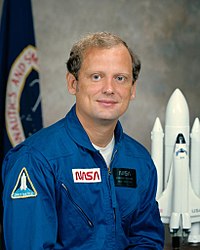Norman Thagard
| Norman Thagard | |
|---|---|

|
|
| Country: | United States |
| Organization: | NASA |
| selected on | January 16, 1978 ( 8th NASA Group ) |
| Calls: | 5 space flights |
| Start of the first space flight: |
June 18, 1983 |
| Landing of the last space flight: |
July 7, 1995 |
| Time in space: | 140d 13h 24min |
| retired on | January 3, 1996 |
| Space flights | |
Norman Earl Thagard (born July 3, 1943 in Marianna , Florida , USA ) is a former American astronaut . He is the first American to fly into space in a Russian spaceship.
Thagard attended Paxon Senior High School in Jacksonville, Florida . He received a bachelor's degree in 1965 and a master's degree in engineering the following year , both from Florida State University . In 1966 he enlisted in the United States Marine Corps , where he trained as a naval aviator for the F4 Phantom , with which he flew 163 combat missions in the Vietnam War . He ended his military career in favor of space travel as a captain with a flight experience of more than 2,200 flight hours.
Astronaut activity
In January 1978, Thagard was selected by NASA as an astronaut aspirant and then trained as a mission specialist.
STS-7
On June 18, 1983, Thagard took off on the space shuttle Challenger for its first flight into space . It was the first mission with a crew of five. During the six-day flight the satellites ANIK C-2 and PALAPA B-1 were deployed . In addition, the research platform SPAS-01 was released and recaptured for the first time with the robotic arm (RMS) . STS-7 was the first flight by an American woman ( Sally Ride ) into space.
STS-51-B
On April 29, 1985 Thagard flew into space again with the space shuttle Challenger. The mission's payload consisted of the Spacelab of the European Space Agency (ESA). 15 experiments were carried out, mainly to investigate liquids and materials in weightless space. Two monkeys and 24 rodents were also on board for biological studies. 14 experiments were successfully carried out. The science satellite NUSAT was also suspended.
STS-61-G
STS-61-G would have been a space shuttle Atlantis mission in May 1986, but was canceled after the Challenger disaster. The Galileo space probe should have been brought into space. David Walker, Ronald Grabe, Norman Thagard and James van Hoften were planned as crew.
STS-30
On May 4, 1989, Thagard flew into space on the space shuttle Atlantis . The payload was the Venus probe Magellan , which was accelerated towards Venus with an IUS upper stage . STS-30 was the first mission in which the space shuttle was used to launch an interplanetary spacecraft.
STS-42
On January 22, 1992, Thagard took off into space as the Discovery's payload commander . The microgravity laboratory IML-1 was located in the space shuttle's payload bay . The Spacelab module contained experiments to explore the complex effects of weightlessness on living organisms and other materials. In order to be able to carry out experiments around the clock, the crew worked in shifts. Thagard formed the blue team together with the astronauts Grabe , Oswald and Bondar , while Hilmers , Readdy and the German Ulf Merbold formed the red team.
Stay on the Mir
On March 14, 1995, Thagard set off for the Mir space station on board the Russian spacecraft Soyuz TM-21 . There he was a member of the 18th regular crew (MIR EO-18) of Mir. 28 experiments were carried out during his 115-day stay in space. On July 7, 1995, Thagard landed on the space shuttle Atlantis ( STS-71 ) at the Kennedy Space Center .
Private
Norman Thagard and his wife Rex Kirby have three sons.
See also
literature
- Stefan Schickedanz: Men's toys - From aggregates, wristwatches and action sports , Acabus (Diplomica) Verlag, Hamburg 2008, ISBN 978-3-941404-46-5
Web links
- Short biography of Norman Thagard at spacefacts.de
- NASA biography of Norman Thagard (English; PDF)
- Biography of Norman Thagard in the Encyclopedia Astronautica (English)
| personal data | |
|---|---|
| SURNAME | Thagard, Norman |
| ALTERNATIVE NAMES | Thagard, Norman Earl |
| BRIEF DESCRIPTION | American astronaut |
| DATE OF BIRTH | July 3, 1943 |
| PLACE OF BIRTH | Marianna (Florida) , Florida |